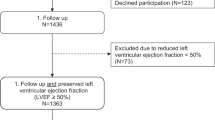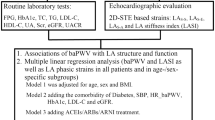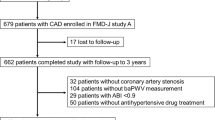Abstract
Brachial–ankle pulse wave velocity (baPWV), a marker of arterial stiffness, is an established cardiovascular risk factor of ventricular stiffening. We studied the association of baPWV with left-ventricular (LV) diastolic function in a sub-study of the Guangzhou Biobank Cohort Study. In all, 378 Chinese subjects with a normal ejection fraction (>50%) had baPWV measurement by a noninvasive automatic waveform analyser, carotid intima-medial thickness (IMT) measurement by B-mode ultrasonography and cardiac diastolic function assessment by echocardiography. After adjusting for age, both baPWV and IMT were associated with LV mass index, posterior wall end-diastolic thickness and inter-ventricular end-diastolic thickness, but only baPWV was associated with deceleration time, atrial flow velocity and E/A ratio. Multivariable linear regression model showed that baPWV and mean arterial pressure, but not IMT, were significantly associated with E/A ratio (β=−0.02, P=0.03 and β=−0.36, P=0.02, respectively). The receiver operator characteristic curve showed that baPWV was better than pulse pressure or mean arterial pressure to detect LV diastolic dysfunction (E/A<1.0). Our study suggested that increased baPWV might be an independent risk factor or marker for diastolic dysfunction. Early detection of an intervention on increased baPWV may be important for prevention of cardiac diastolic dysfunction.
This is a preview of subscription content, access via your institution
Access options
Subscribe to this journal
Receive 12 digital issues and online access to articles
$119.00 per year
only $9.92 per issue
Buy this article
- Purchase on SpringerLink
- Instant access to full article PDF
Prices may be subject to local taxes which are calculated during checkout

Similar content being viewed by others
References
Yamashina A, Tomiyama H, Arai T, Hirose K, Koji Y, Hirayama Y et al. Brachial-ankle pulse wave velocity as a marker of atherosclerotic vascular damage and cardiovascular risk. Hypertens Res 2003; 26 (8): 615–622.
van Popele NM, Grobbee DE, Bots ML, Asmar R, Topouchian J, Reneman RS et al. Association between arterial stiffness and atherosclerosis: the Rotterdam Study. Stroke 2001; 32 (2): 454–460.
Tomiyama H, Koji Y, Yambe M, Shiina K, Motobe K, Yamada J et al. Brachial–ankle pulse wave velocity is a simple and independent predictor of prognosis in patients with acute coronary syndrome. Circ J 2005; 69 (7): 815–822.
Yu WC, Chuang SY, Lin YP, Chen CH . Brachial-ankle vs carotid-femoral pulse wave velocity as a determinant of cardiovascular structure and function. J Hum Hypertens 2008; 22 (1): 24–31.
Ren X, Ristow B, Na B, Ali S, Schiller NB, Whooley MA . Prevalence and prognosis of asymptomatic left ventricular diastolic dysfunction in ambulatory patients with coronary heart disease. Am J Cardiol 2007; 99 (12): 1643–1647.
Redfield MM, Jacobsen SJ, Burnett Jr JC, Mahoney DW, Bailey KR, Rodeheffer RJ . Burden of systolic and diastolic ventricular dysfunction in the community: appreciating the scope of the heart failure epidemic. JAMA 2003; 289 (2): 194–202.
Fischer M, Baessler A, Hense HW, Hengstenberg C, Muscholl M, Holmer S et al. Prevalence of left ventricular diastolic dysfunction in the community. Results from a Doppler echocardiographic-based survey of a population sample. Eur Heart J 2003; 24 (4): 320–328.
Abhayaratna WP, Marwick TH, Smith WT, Becker NG . Characteristics of left ventricular diastolic dysfunction in the community: an echocardiographic survey. Heart 2006; 92 (9): 1259–1264.
Yambe M, Tomiyama H, Hirayama Y, Gulniza Z, Takata Y, Koji Y et al. Arterial stiffening as a possible risk factor for both atherosclerosis and diastolic heart failure. Hypertens Res 2004; 27 (9): 625–631.
Abhayaratna WP, Srikusalanukul W, Budge MM . Aortic stiffness for the detection of preclinical left ventricular diastolic dysfunction: pulse wave velocity versus pulse pressure. J Hypertens 2008; 26 (4): 758–764.
Jiang CQ, Thomas GN, Lam TH, Schooling CM, Zhang W, Lao X et al. Cohort profile: The Guangzhou Biobank Cohort Study, a Guangzhou-Hong Kong-Birmingham collaboration. Int J Epidemiol 2006; 35 (4): 844–852.
Jiang CQ, Lam TH, Lin JM, Liu B, Yue XJ, Cheng KK et al. An overview of the Guangzhou Biobank Cohort Study-Cardiovascular Disease Subcohort (GBCS-CVD): a platform for multidisciplinary collaboration. J Hum Hypertens 2010; 24 (2): 139–150.
Deng HB, Macfarlane DJ, Thomas GN, Lao XQ, Jiang CQ, Cheng KK et al. Reliability and validity of the IPAQ-Chinese: the Guangzhou Biobank Cohort study. Med Sci Sports Exerc 2008; 40 (2): 303–307.
Jiang CQ, Lao XQ, Yin P, Thomas GN, Zhang WS, Liu B et al. Smoking, smoking cessation and aortic arch calcification in older Chinese: the Guangzhou Biobank Cohort Study. Atherosclerosis 2009; 202 (2): 529–534.
Thomas GN, Young RP, Tomlinson B, Anderson PJ, Woo KS, Sanderson JE et al. A sibling-pair analysis of fasting lipids and anthropometric measurements and their relationship to hypertension. Clin Exp Hypertens 1999; 21 (7): 1161–1176.
Devereux RB, Reichek N . Echocardiographic determination of left ventricular mass in man. Anatomic validation of the method. Circulation 1977; 55 (4): 613–618.
Lubien E, DeMaria A, Krishnaswamy P, Clopton P, Koon J, Kazanegra R et al. Utility of B-natriuretic peptide in detecting diastolic dysfunction: comparison with Doppler velocity recordings. Circulation 2002; 105 (5): 595–601.
Yamashina A, Tomiyama H, Takeda K, Tsuda H, Arai T, Hirose K et al. Validity, reproducibility, and clinical significance of noninvasive brachial-ankle pulse wave velocity measurement. Hypertens Res 2002; 25 (3): 359–364.
Eren M, Gorgulu S, Uslu N, Celik S, Dagdeviren B, Tezel T . Relation between aortic stiffness and left ventricular diastolic function in patients with hypertension, diabetes, or both. Heart 2004; 90 (1): 37–43.
Abhayaratna WP, Barnes ME, O’Rourke MF, Gersh BJ, Seward JB, Miyasaka Y et al. Relation of arterial stiffness to left ventricular diastolic function and cardiovascular risk prediction in patients > or =65 years of age. Am J Cardiol 2006; 98 (10): 1387–1392.
Laurent S, Cockcroft J, Van Bortel L, Boutouyrie P, Giannattasio C, Hayoz D et al. Expert consensus document on arterial stiffness: methodological issues and clinical applications. Eur Heart J 2006; 27 (21): 2588–2605.
Weber T, O’Rourke MF, Ammer M, Kvas E, Punzengruber C, Eber B . Arterial stiffness and arterial wave reflections are associated with systolic and diastolic function in patients with normal ejection fraction. Am J Hypertens 2008; 21 (11): 1194–1202.
Roman MJ, Ganau A, Saba PS, Pini R, Pickering TG, Devereux RB . Impact of arterial stiffening on left ventricular structure. Hypertension 2000; 36 (4): 489–494.
Chae CU, Pfeffer MA, Glynn RJ, Mitchell GF, Taylor JO, Hennekens CH . Increased pulse pressure and risk of heart failure in the elderly. JAMA 1999; 281 (7): 634–639.
Zile MR, Gaasch WH, Carroll JD, Feldman MD, Aurigemma GP, Schaer GL et al. Heart failure with a normal ejection fraction: is measurement of diastolic function necessary to make the diagnosis of diastolic heart failure? Circulation 2001; 104 (7): 779–782.
How to Diagnose Diastolic Heart Failure. European Study Group on Diastolic Heart Failure. Eur Heart J 1998; 19 (7): 990–1003.
Safar ME, Levy BI, Struijker-Boudier H . Current perspectives on arterial stiffness and pulse pressure in hypertension and cardiovascular diseases. Circulation 2003; 107 (22): 2864–2869.
Wang CP, Hung WC, Yu TH, Hsu HL, Chen YH, Chiu CA et al. Brachial-ankle pulse wave velocity as an early indicator of left ventricular diastolic function among hypertensive subjects. Clin Exp Hypertens 2009; 31 (1): 31–43.
Mizuguchi Y, Tanaka H, Oishi Y, Miyoshi H, Emi S, Ishimoto T et al. Predictive value of associations between carotid arterial sclerosis and left ventricular diastolic dysfunction in patients with cardiovascular risk factors. J Am Soc Echocardiogr 2007; 20 (7): 806–812.
Agoston-Coldea L, Mocan T, Bobar C . Arterial stiffness and left ventricular diastolic function in the patients with hypertension. Rom J Intern Med 2008; 46 (4): 313–321.
Guntekin U, Gunes Y, Gunes A, Ceylan Y, Gumrukcuoglu HA, Yucel Y et al. Noninvasive assessment of atherosclerosis in patients with isolated hypertension. Echocardiography 2009; 27 (2): 155–160.
Meijs MF, Doevendans PA, Cramer MJ, Vonken EJ, Velthuis BK, van der Graaf Y ; et al. Relation of common carotid intima-media thickness with left ventricular mass caused by shared risk factors for hypertrophy. J Am Soc Echocardiogr 2009; 22 (5): 499–504.
Parrinello G, Colomba D, Bologna P, Licata A, Pinto A, Paterna S et al. Early carotid atherosclerosis and cardiac diastolic abnormalities in hypertensive subjects. J Hum Hypertens 2004; 18 (3): 201–205.
Acknowledgements
The study is funded by the National Natural Science Foundation of China/Research Grants Council (No. 30518001; HKU720/05) Grant. The main cohort study was funded by The University of Hong Kong Foundation for Education and Science, Hong Kong; Guangzhou Public Health Bureau, and Guangzhou Science and Technology Committee, Guangzhou, China; and The University of Birmingham, UK. The Guangzhou Cohort Study-Cardiovascular Disease Subcohort (GBCS-CVD) investigators include Guangzhou No. 12 Hospital: Jie Ming Lin, Bin Liu, Xiao Jun Yue, Chao Qiang Jiang (co-PI); The University of Hong Kong: Tai Hing Lam (co-PI); The Chinese University of Hong Kong: Brian Tomlinson, Ka Sing Wong; The University of Birmingham: Bernard MY Cheung, Shahrad Taheri, Paramjit Gill, Greg YH Lip, Kar Keung Cheng, G Neil Thomas (co-PI).
Author information
Authors and Affiliations
Corresponding author
Ethics declarations
Competing interests
The authors declare no conflict of interest.
Rights and permissions
About this article
Cite this article
Xu, L., Jiang, C., Lam, T. et al. Arterial stiffness and left-ventricular diastolic dysfunction: Guangzhou Biobank Cohort Study-CVD. J Hum Hypertens 25, 152–158 (2011). https://doi.org/10.1038/jhh.2010.44
Received:
Revised:
Accepted:
Published:
Issue Date:
DOI: https://doi.org/10.1038/jhh.2010.44



